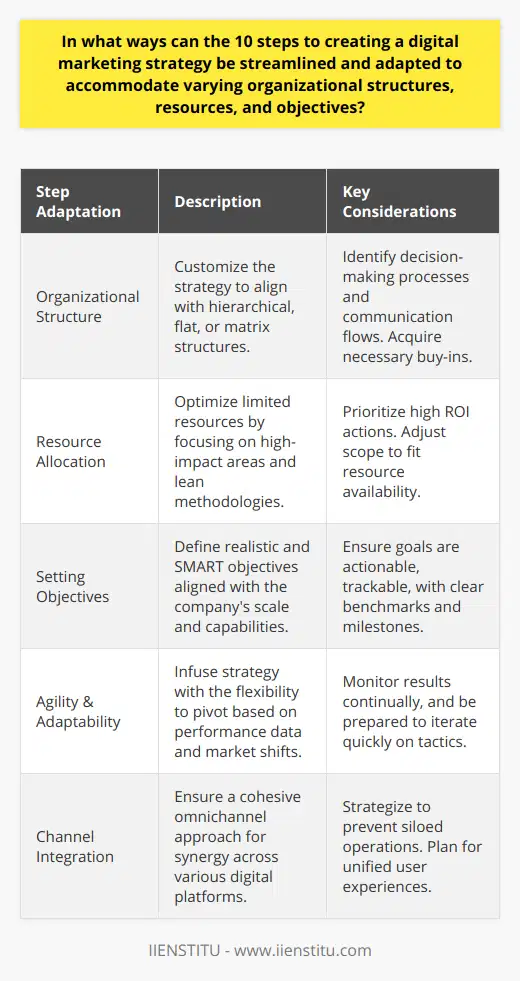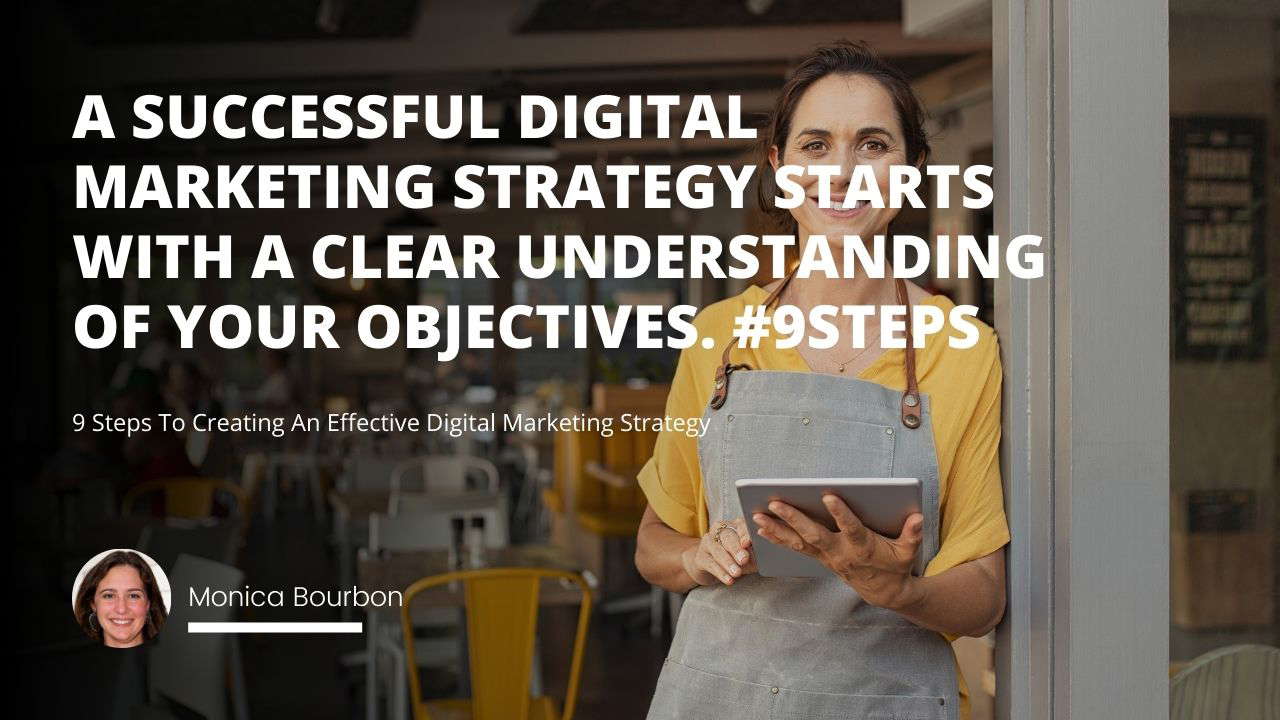
Creating a digital marketing strategy can seem daunting, but it's essential to have a plan if you want your business to grow. In this guide, we'll walk you through the steps you need to take to create an effective strategy. We'll cover everything from developing your goals and target audience to creating content and measuring results. By following these tips, you'll be on your way to success!
What is a digital marketing strategy?
A digital marketing strategy is a business plan to promote its products or services online. This can include SEO tactics to make sure their website appears in search engine results and paid advertising campaigns on social media or other websites. A digital marketing strategy also encompasses email marketing, content marketing, and mobile marketing. Any form of marketing done online can be considered part of a digital marketing strategy. A digital marketing strategy aims to reach more potential customers and convert them into paying customers. Businesses need to make sure they are visible online and that their digital marketing campaigns are effective. By developing a comprehensive digital marketing strategy, companies can ensure that they are making the most of the digital world.
Why is digital marketing important?
Digital marketing is essential because it allows businesses to reach a larger audience than otherwise. Companies can only get people in their immediate area with traditional marketing methods. With digital marketing, companies can target customers all over the world. This is especially useful for companies that sell products or services online. By using digital marketing tactics, companies can reach a wider audience and increase their chances of making a sale.
1. Traditional marketing is no longer as effective as it used to be
2. Digital marketing allows you to target a specific audience
3. Digital marketing is cost-effective
4. You can track the results of your digital marketing campaigns
5. Digital marketing is evolving all the time so that you can keep up with the latest trends
What are the steps to creating a digital marketing strategy?
1. Define your goals and objectives: The first step to creating a digital marketing strategy is to define what you want to achieve. Do you want to increase brand awareness? Drive more traffic to your website? Increase online sales? Once you know what your goals are, you can develop a plan to achieve them.
2. Research your target market: Knowing who your target market is will help you determine what digital marketing tactics to use. If you're selling products or services to businesses, you'll need to use different tactics than if you're targeting consumers. For example, businesses are more likely to use search engine optimization (SEO) and pay-per-click (PPC) advertising than consumers. This is because companies are more likely to search for keywords related to their products or services, and they're also willing to pay for ads that appear in search results.
3. Identify your crucial marketing channels: Once you know your target market, you need to identify where they can be found online. This will help you determine what digital marketing tactics to use. For example, if your target market is businesses, you'll want to focus on tactics like SEO and PPC advertising. On the other hand, if your target market is consumers, you'll want to focus on tactics like content marketing and social media marketing.
4. Create content for your marketing channels: Once you know what digital marketing tactics you'll use, it's time to create the actual content. This can include blog posts, videos, infographics, and other types of content that will help you reach your target audience. Also, remember to include calls to action (CTAs) in your content so that people know what to do next.
5. Analyze and optimize your campaigns: Once you've launched your digital marketing campaigns, it's essential to monitor their performance and make changes as needed. This can include adjusting your budget, changing your content, or altering your digital marketing tactics.
6. Evaluate your results and adjust your strategy as needed: The final step in creating a digital marketing strategy is to evaluate the results of your campaigns and adapt your strategy accordingly. This will help you fine-tune your tactics and ensure that you're getting the most out of your digital marketing efforts.
Digital marketing is a powerful tool that businesses can use to reach more potential customers. By developing a comprehensive digital marketing strategy, companies can ensure that they are making the most of the digital world.
The best digital marketing strategy books
Several popular books focus on digital marketing strategy. For example, in "The Lean Startup," Eric Ries provides an overview of the lean startup methodology, which many tech startups have used to achieve success. In addition, "The Marketing Playbook" by John Jantsch offers a step-by-step guide to creating and implementing a successful marketing strategy. And "The Innovator's Dilemma" by Clayton Christensen looks at how companies can respond to disruptive innovations in their industry. These are just a few of the many books that offer insights into how to create and execute a successful digital marketing strategy.
Best digital marketing strategies list
The best digital marketing strategy will vary depending on the business's goals. However, businesses can use some common tactics to improve their digital marketing efforts. These include:
1. Creating a solid website: A business's website is often the first point of contact for potential customers. As such, it's essential to make sure that your website is designed to impress and convert visitors. This means having a well-designed website with clear calls to action (CTAs) and relevant, informative content.
2. Optimizing for search engines: Search engine optimization (SEO) is essential for ranking your website high in search results. This can be accomplished by using relevant keywords in your content, building backlinks to your website, and creating informative and engaging content.
3. Using social media: Social media is a great way to connect with potential and current customers. By posting relevant and engaging content, businesses can build relationships with their customers and create a community of followers. Additionally, social media can drive traffic to your website and promote your products or services.
4. Creating compelling content: Content is one of the most critical aspects of digital marketing. By creating explicit, engaging, and informative content, businesses can attract more attention from their target audience. Content can come in many forms, such as blog posts, videos, infographics, etc.
5. Analyzing data: Data analysis is critical for understanding what's working and not in your digital marketing efforts. By tracking your website traffic, social media engagement, and conversion rates, you can adjust your strategy to improve your results.
Digital marketing is a vast and complex field. However, by following these tips, you can create a digital marketing strategy that will help you reach your target audience and achieve your business goals.
Having a well-defined digital marketing strategy is essential for any business, large or small. By taking the time to research your target market, identify your key marketing channels, and create relevant content, you can set yourself up for success. However, it's important to remember that no strategy is static; you must continually analyze and optimize your campaigns to achieve the best results. If you're looking for more guidance on creating and executing a successful digital marketing plan, consider enrolling in our Digital Marketing Course. This comprehensive online program will give you all the tools you need to succeed in today's competitive online landscape. There's no reason not to get started today with so much at stake.
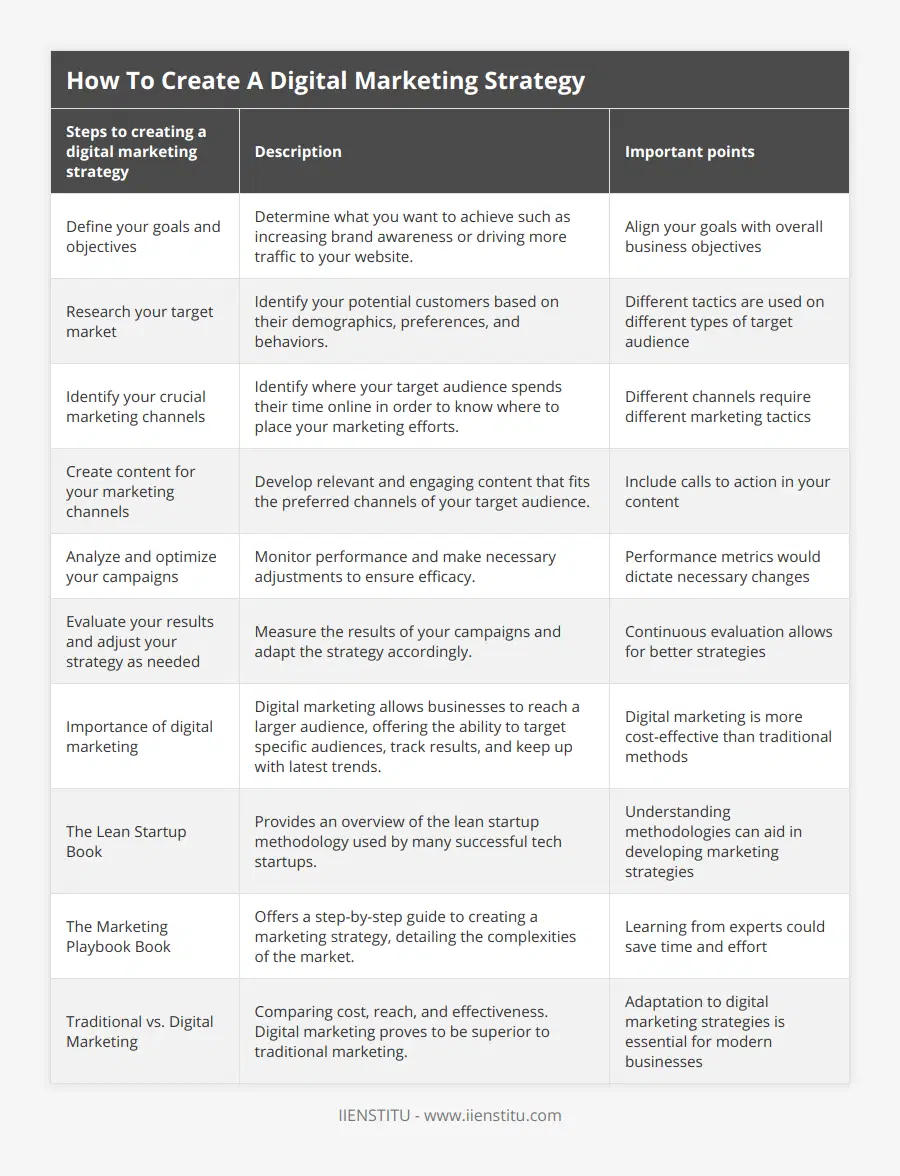
Frequently Asked Questions
What type of digital marketing strategies have you found to be most effective?
There are a lot of different digital marketing strategies that can be effective, depending on the business and what they are trying to sell or promote. For some businesses, effective digital marketing might mean focusing on SEO in order to get their website to show up higher in search results. For others, social media might be the best platform for engaging with potential customers. And for still others, email marketing could be the most successful tactic.
What do you think is the best way to measure the effectiveness of a digital marketing campaign?
There is no single answer to this question. Some factors you may want to consider are:
-The size and complexity of the digital marketing campaign
-The target audience for the campaign
-The goals of the campaign
-The budget allocated to the campaign
What is your favorite digital marketing strategy?
My favorite digital marketing strategy is to use SEO keywords in order to drive organic traffic to my website. I love using Google AdWords and other PPC platforms, but there is something special about getting people to your site without having to pay for each click. It feels more organic and sustainable, plus it doesn't put a strain on your marketing budget.
I also really enjoy using social media platforms to connect with potential customers and build relationships. I think social media is a great way to connect with people who might be interested in what you have to offer, and it's also a great way to build brand awareness.
What are the key components in the 7 P's of digital marketing?
Introduction
The 7 P's of digital marketing are essential components for businesses to develop a successful online strategy. These components help organizations optimize their marketing efforts, enhance customer experience, and drive revenue growth.
Product
The first P refers to the product, which focuses on understanding the target audience's needs and developing a compelling offering that solves the customers' problems. This includes presenting the unique selling proposition effectively, differentiating the product from the competition, and spotlighting the key features and benefits.
Price
The second P is the price, which involves determining the right pricing strategy and evaluating factors such as production costs, market demand, and competitor pricing. This component aims to strike a balance between profitability and customer perceived value, allowing companies to remain competitive while maximizing revenue.
Place
The third essential component is the place, which refers to the distribution channels chosen by a business for its products or services. This involves researching customer preferences for online locations, such as e-commerce platforms, social media channels, or a company website, to ensure accessibility, discoverability, and convenience for the target audience.
Promotion
The fourth P is the promotion, which involves creating an engaging digital marketing strategy that effectively communicates the product's value proposition to the target audience. This includes using various promotional tools, such as search engine optimization, online advertising, social media marketing, email marketing, and content marketing, to create awareness and drive conversions.
People
The fifth P refers to the people responsible for executing an organization's digital marketing strategy. This includes having skilled marketers, sales representatives, customer support staff, and content creators who ensure that a brand's online presence is authentic, relatable, and customer-centric while also driving growth and loyalty.
Process
The sixth P is the process, which entails mapping out the customer journey and optimizing the entire user experience when interacting with the brand online. This includes streamlining website navigation, simplifying the buying process, and improving post-purchase services, such as customer support and returns policy, to ensure a seamless experience and increase customer satisfaction.
Physical Evidence
Lastly, the seventh P is physical evidence, which refers to the tangible aspects of a business's digital presence that creates trust and credibility. This includes elements such as website design, online reviews, testimonials, and case studies, which showcase a company's reputation and expertise in the digital sphere, strengthening its brand image and fostering customer trust.
Conclusion
To sum up, the 7 P's of digital marketing play a crucial role in building an effective online strategy that drives growth and customer satisfaction. By focusing on product, price, place, promotion, people, process, and physical evidence, businesses can improve their digital presence, meet consumer expectations, and create a sustainable competitive advantage.
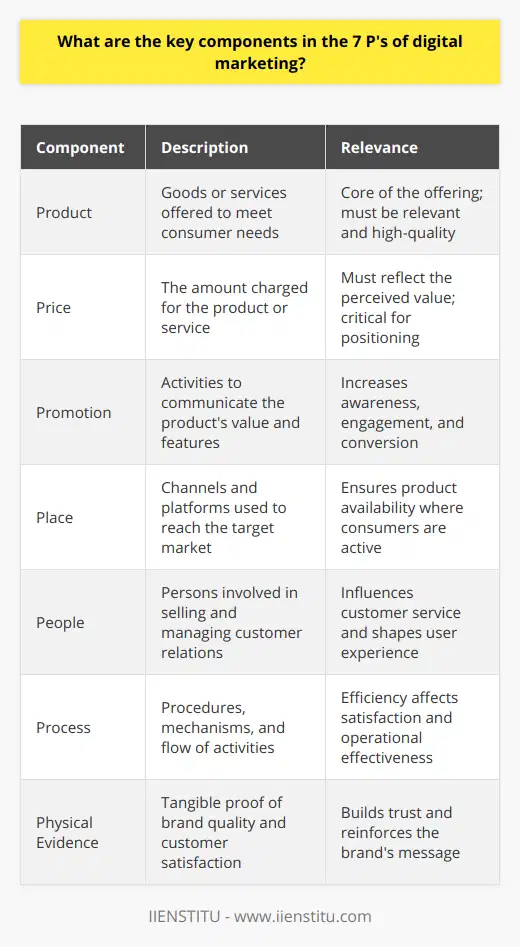
How can one effectively combine the 5 stages of planning a digital marketing strategy?
Understanding the Five Stages of a Digital Marketing Strategy
**1. Establishing Objectives**
Effective combination of the five stages of planning a digital marketing strategy begins with establishing clear and measurable objectives. These objectives guide the overall strategy and align with the business goals, allowing for a more targeted and focused digital marketing approach.
**2. Performing an Audit**
Once the objectives are established, a comprehensive audit of the organization's current digital presence should be conducted. This involves assessing the current state of the website, social media presence, content quality, and performance of existing digital marketing channels. A thorough audit provides a benchmark for measuring the effectiveness of the implemented strategy.
**3. Developing a Strategy**
With sufficient data gathered, it is essential to develop a comprehensive digital marketing strategy aimed at achieving the established objectives. This stage involves exploring different online channels and tactics, mapping out buyer personas, and creating a content plan tailored to the target audience's preferences and purchasing behavior.
**4. Implementing the Strategy**
In the implementation stage, the planned digital marketing initiatives are put into action. This involves optimizing the organization's website for search engines, designing engaging social media campaigns, creating valuable and informative content, and utilizing appropriate digital advertising channels. Efficient execution of the strategy ensures that the marketing initiatives generate maximum results and contribute to achieving the set objectives.
**5. Monitoring and Optimization**
Lastly, ongoing monitoring and optimization of the digital marketing strategy are crucial. By consistently analyzing data and tracking the performance of the implemented initiatives, it is possible to identify areas that require improvement or adjustments. This constant evaluation process enables organizations to fine-tune their digital marketing strategy, ensuring the achievement of the specified objectives and maximizing overall effectiveness.
In conclusion, effectively combining the five stages of planning a digital marketing strategy requires clear objectives, thorough audit and analysis, strategic development, efficient implementation, and continuous monitoring and optimization. By adhering to these core principles, organizations can create a successful and sustainable digital marketing strategy that helps achieve desired business goals.
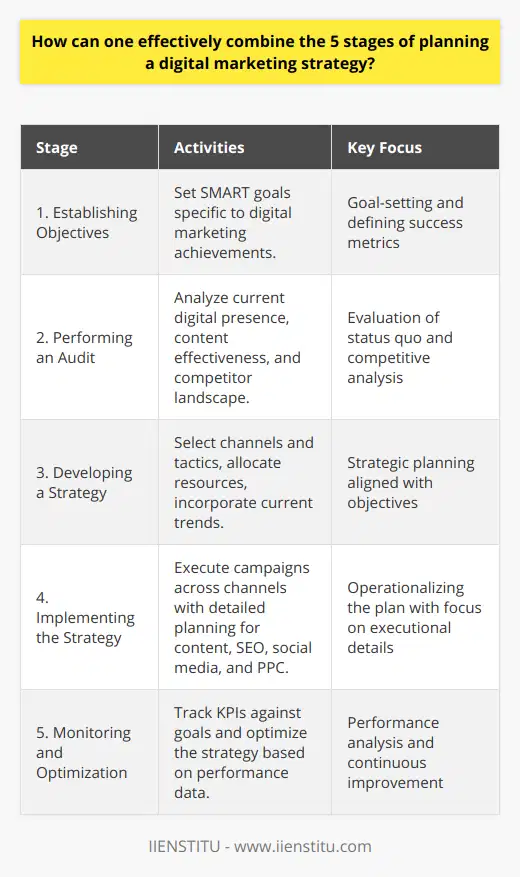
In what ways do the 9 steps to creating a digital marketing strategy facilitate the overall process of developing a successful online marketing plan?
Identifying Objectives and Goals
The 9 steps to creating a digital marketing strategy facilitate the process of developing a successful online marketing plan by first helping businesses identify their objectives and goals. Outlining clear targets, such as increasing brand awareness or boosting conversions, ensures comprehensive planning and informed decision-making for subsequent stages.
Defining Target Audience
Next, understanding the target audience aids in creating tailored content and campaigns. By analyzing demographic information, buyer personas, and customer behavior, the strategy becomes targeted and personalized, leading to improved engagement and higher chances of conversion.
Setting SMART Goals
Once the target audience is defined, setting SMART (Specific, Measurable, Achievable, Relevant, Time-bound) goals improves the strategy's effectiveness. These goals allow marketers to measure progress, identify areas for improvement, and ensure alignment with overall business objectives.
Selecting Marketing Channels
To optimize resources, it is crucial to select appropriate marketing channels. By identifying where the target audience spends most of their time and focusing on platforms that align with the product or service, the strategy becomes more effective in generating leads and conversions.
Creating High-quality Content
Developing a content marketing plan is crucial for customer engagement, education, and retention. By producing high-quality content in various formats, such as blog posts, videos, and social media updates, businesses can showcase their expertise and establish trust with potential clients.
Search Engine Optimization
Integrating search engine optimization (SEO) techniques helps increase website visibility by ranking higher on search engine result pages. By optimizing content, targeting relevant keywords, and building authoritative backlinks, businesses can generate organic traffic and improve brand recognition.
Social Media Marketing
Utilizing social media channels enhances brand presence and customer engagement. Developing shareable content, interacting with the community, and tracking key performance indicators (KPIs) enables businesses to grow their audience, increase brand loyalty, and drive traffic to their website.
Email Marketing Campaigns
Implementing email marketing campaigns is another essential step as it helps maintain customer retention and drive repeat purchases. By creating segmented lists and personalized content, businesses can deliver targeted messages to customers based on their preferences and purchase history.
Monitoring and Analyzing Results
Finally, the 9-step digital marketing strategy emphasizes the importance of consistent monitoring and analysis. By tracking KPIs, identifying trends, and utilizing web analytics tools, marketers can adapt their strategies in real-time, making necessary adjustments to optimize performance and generate maximum return on investment (ROI).
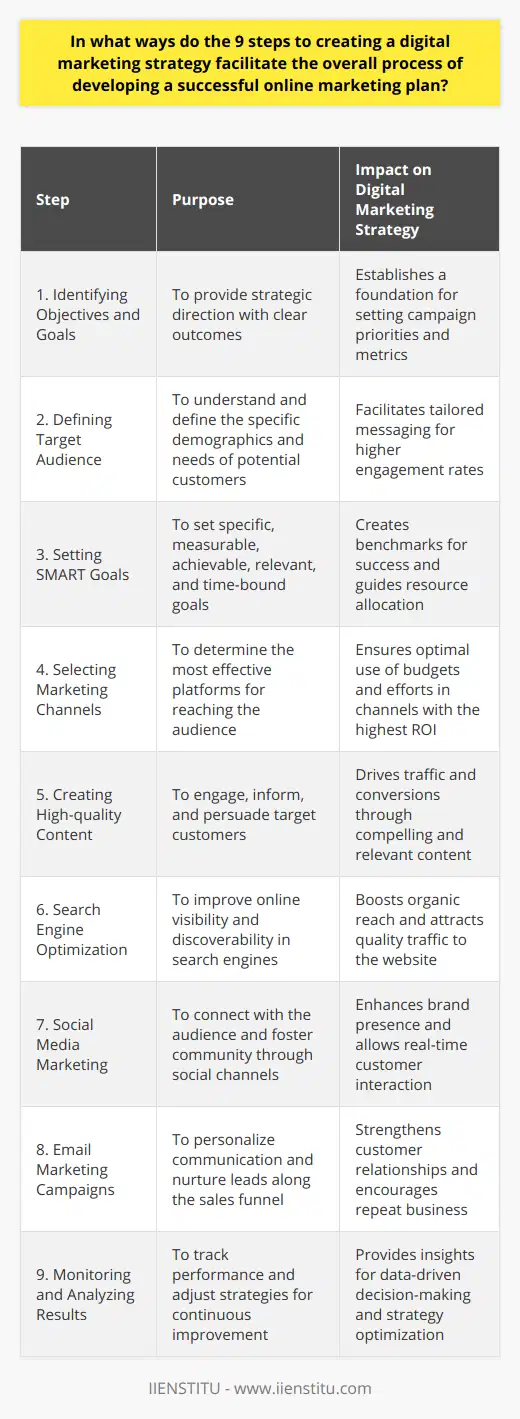
What are the key differences between the 4 digital marketing strategies and how can they be effectively integrated?
Comparing Key Digital Marketing Strategies
Four main digital marketing strategies are identified as search engine optimization (SEO), pay-per-click (PPC) advertising, content marketing, and social media marketing. Each strategy offers unique advantages in targeting and engaging online users, requiring different approaches for successful integration.
Exploring SEO and PPC
SEO focuses on optimizing a website's content, structure, and metadata to increase its visibility in organic search results. It involves keyword research, content optimization, and improving website architecture to enhance user experience. On the other hand, PPC advertising involves creating paid ads that appear at the top of search results, charging the advertiser for each click on the ad. A combination of both strategies ensures broader visibility in search results, using SEO for long-term traffic growth and PPC for immediate, targeted exposure.
Understanding Content Marketing
Content marketing involves creating and distributing valuable, relevant, and consistent content to attract, engage, and retain a clearly defined audience. This strategy aims to establish authority and credibility by providing useful information that addresses users' needs and preferences. Integrating content marketing with SEO and PPC not only bolsters organic search rankings but also provides compelling material for targeted ads, creating a seamless user experience and maximizing the effectiveness of online marketing efforts.
Delving into Social Media Marketing
Social media marketing leverages various social media platforms to promote a brand's products, services, or content. This strategy involves create engaging content and fostering user-generated content to reach a wide audience through shares, likes, and comments. By integrating social media with other digital marketing strategies, businesses can boost audience reach and engage users more effectively. Sharing relevant content and promoting PPC ads on social media platforms can amplify the impact of marketing campaigns, creating a cohesive online presence.
Achieving Effective Integration
To successfully integrate these strategies, it is critical to develop a clear understanding of the target audience, and tailor marketing approaches accordingly. Establishing measurable goals and key performance indicators can further help in evaluating the efficacy of each strategy and identifying areas for improvement. Ultimately, a comprehensive, data-driven approach to digital marketing ensures that businesses can harness the full potential of various strategies while maximizing ROI and driving sustainable growth.

How do the 5 stages of planning a digital marketing strategy ensure a comprehensive and cohesive approach to online marketing?
Understanding the Planning Stages
One cannot overstate the importance of implementing a comprehensive and cohesive digital marketing approach in today's increasingly competitive online landscape. A formidable plan is mandatory to achieve success, and the five stages of planning a digital marketing strategy provide marketers with a robust framework for constructing a foolproof, holistic approach. Each stage plays an integral role in ensuring that the overall strategy aligns with the target audience, business goals, and available resources.
Setting SMART Objectives
The first step in planning a digital marketing strategy involves defining clear, specific, measurable, achievable, relevant, and time-bound (SMART) objectives. Establishing these objectives lays the groundwork for the rest of the strategy since goals drive every subsequent decision. This initial stage also enables marketers to set performance indicators that facilitate periodic evaluation of the plan's effectiveness and the return on investment (ROI).
Conducting Thorough Research
Robust research forms the second stage of digital marketing strategy planning. This stage encompasses a comprehensive audit of current marketing efforts, a SWOT analysis of the brand, evaluation of competitors, and identification of the target audience. Having a detailed understanding of the consumer's preferences, habits, and demographics helps marketers develop personalized content, consequently increasing engagement and conversion rates. Additionally, consistent competitor analysis can reveal gaps and opportunities to capitalize on for a strategic advantage.
Plan and Create Relevant Content
A well-researched and carefully-constructed content strategy forms the heart of any successful digital marketing campaign. The third step involves planning and creating content that addresses the needs and preferences of the target audience, delivering value and facilitating user engagement. The focus should always lie on quality over quantity to ensure relevance, effectiveness, and to maintain a strong brand presence across various digital channels.
Implement and Manage Campaigns
Launching campaigns and monitoring their performance comprise the fourth stage of digital marketing strategy planning. This step includes implementing the campaigns, establishing conversion funnels, and utilizing appropriate marketing tools for tracking and assessing performance. Continual monitoring of campaigns allows marketers to acquire insights and optimize their strategies to improve future results constantly. Implementing a proactive management approach also helps businesses adapt to market changes quickly and efficiently.
Analyze, Evaluate, and Adapt
The final stage in the strategy is the critical process of analyzing and evaluating the results of the campaign against the set objectives. Leveraging analytics data identifies areas for improvement, lessons learned and insights into user behavior, which are essential in adapting and refining future digital marketing campaigns. This final stage allows for continual growth, evolution, and enhancement of digital marketing strategies in response to market changes and consumer behavior.
In conclusion, the five stages of planning a digital marketing strategy provide a comprehensive and cohesive approach to online marketing. By adhering to these stages, marketers can ensure alignment with their target audience, business objectives, and resources, ultimately achieving superior results in the highly competitive digital landscape.
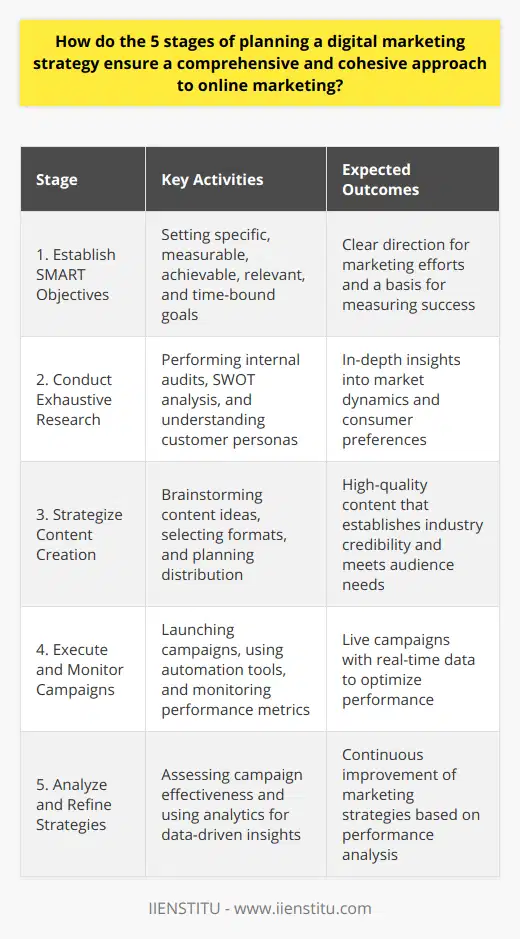
What are the most common challenges faced during the 9 steps to creating a digital marketing strategy and how can they be overcome?
Challenges in Digital Marketing Strategy Development
Establishing a Target Market
A common challenge in the initial stage of creating a digital marketing strategy is accurately identifying the target market. To overcome this, businesses should conduct thorough market research, analyzing demographic data, consumer behavior, and competitors' strategies for more effective segmentation.
Determining Clear Goals and Objectives
Ambiguous or unrealistic goals can hinder the success of a digital marketing campaign. To set achievable objectives, businesses should employ the SMART (Specific, Measurable, Achievable, Relevant, Time-bound) framework, ensuring that goals are well-defined, quantifiable, and aligned with the company's broader objectives.
Selection of Suitable Channels
Choosing the right channels to communicate marketing strategies can be complex, given the plethora of platforms available. To address this, marketers must consider the preferences of their target audience, platform-specific features, and budget constraints to ensure an appropriate and optimized channel selection.
Content Creation and Curation
Generating compelling and relevant content may pose challenges for businesses lacking creative resources or expertise. Outsourcing content creation or leveraging user-generated content can help these businesses overcome such limitations while maintaining communication with their audience.
Engagement and Interaction
Maintaining audience engagement and responding to customer queries in a timely manner is necessary to enhance brand reputation. Automated tools like chatbots, followed by personalized human assistance, can facilitate efficient customer interaction while reducing operational costs.
Search Engine Optimization (SEO)
Effective SEO implementation to improve search engine results rankings often proves difficult for businesses. To tackle these challenges, businesses must keep up-to-date with search engine algorithm updates, utilize keyword research, and focus on quality backlinks to optimize their digital marketing strategies.
Performance Measurement
Digital marketing strategy success relies heavily on quantifying performance. Overcoming this challenge requires businesses to adopt a focused data-driven approach, using analytics tools such as Google Analytics to monitor key performance indicators (KPIs) related to their objectives.
Budget Constraints
The allocation of resources and budgetary limitations often constrain digital marketing efforts. To overcome this, businesses should prioritize cost-effective strategies such as organic social media growth and targeted email marketing campaigns.
Adapting to Changing Trends
The digital landscape evolves rapidly, and marketers must remain agile to adapt to trends and developments. Staying informed about industry advancements and conducting periodic strategy reviews will ensure that digital marketing efforts remain relevant in a dynamic environment.
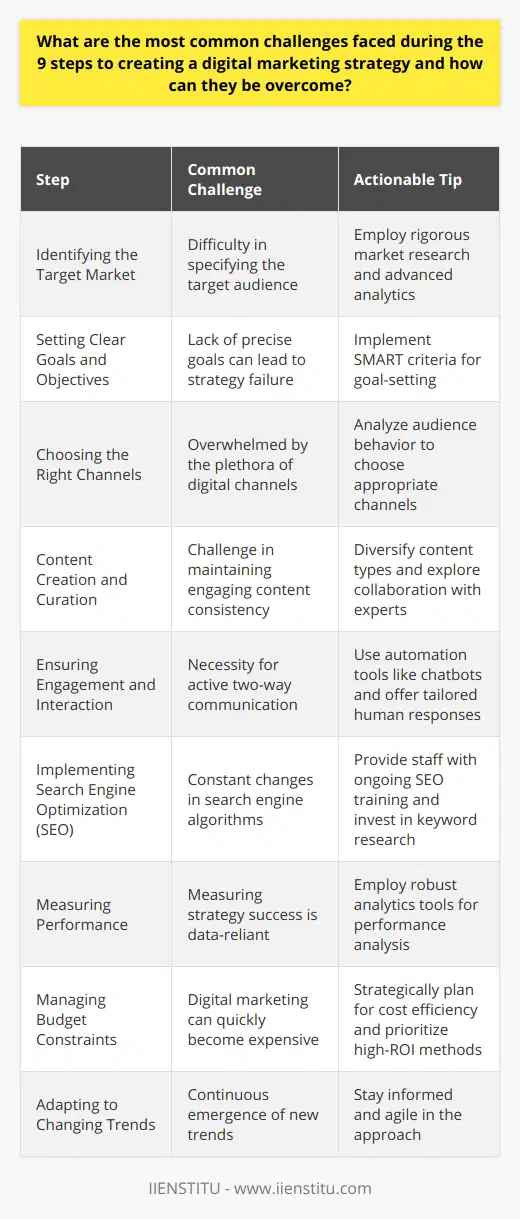
How do I formulate a digital marketing strategy that takes into account the unique characteristics of my target audience?
Understanding the Target Audience
To formulate a digital marketing strategy that effectively considers the unique characteristics of the target audience, marketers must first conduct comprehensive audience research to identify the needs, preferences, and behaviors of potential customers. Analyzing demographic factors such as age, gender, and location, along with psychographic attributes like interests and values, is crucial for tailoring marketing messages that resonate with the intended recipients.
Defining Objectives and KPIs
Once the target audience has been identified, it is essential to establish clear objectives and Key Performance Indicators (KPIs) to track the success of the marketing strategy. KPIs may include indicators such as website traffic, conversion rates, and social media engagement metrics. Aligning these objectives with the specific characteristics of the target audience will help ensure that the marketing initiatives are appropriately adjusted to maximize effectiveness.
Selecting Appropriate Marketing Channels
Effective digital marketing relies on using the right mix of channels to communicate with the target audience. Therefore, marketers should prioritize channels that will help them reach and engage with the identified audience. For instance, if the target audience mostly comprises young people, focusing on social media platforms popular among that demographic may yield better results. Additionally, considering the audience's preferences regarding content consumption, such as format (video, text, or images), can further optimize the strategy.
Creating Engaging Content
In digital marketing, content is king. To engage and attract the target audience, marketers should develop content that is relevant, valuable, and interesting. This can be achieved by addressing the audience's pain points, answering their questions, and providing solutions to their problems. Additionally, aligning content with the unique characteristics of the target audience ensures that the content resonates with them and motivates them to take the desired action.
Monitoring and Adjusting the Strategy
Digital marketing strategies should not remain static but rather be evaluated and adjusted regularly in response to audience feedback and changing market conditions. Monitoring KPIs, analyzing campaign data, and gauging customer satisfaction are essential activities that help marketers understand what works and what needs improvement. By continuously refining the strategy based on audience insights, marketers can optimize their marketing efforts and ensure that their approach aligns with the evolving preferences and behaviors of their target audience.
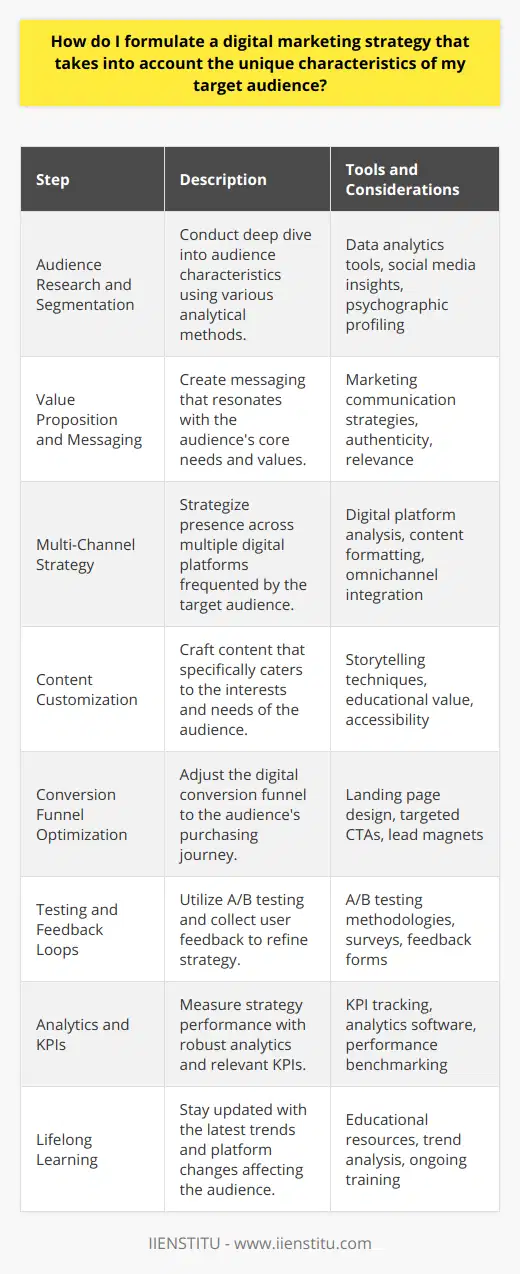
What are the essential factors to consider when creating a digital strategy to ensure a successful and measurable campaign?
Key Factors in Creating an Effective Digital Strategy
Understanding the Target Audience
The primary factor is to understand the target audience. This involves defining their demographics, preferences, and browsing habits, ensuring that the campaign is tailored to resonate with viewers, and effectively positioning the promoted content.
Setting Clear and Achievable Goals
Having a set of clear and achievable objectives is essential. This could involve increasing website traffic, growing email lists, or building brand awareness, as these goals will help guide decision-making during the digital strategy's development and implementation.
Establishing Metrics for Success
Identifying measurable metrics to gauge the success of a digital campaign is a critical aspect. Key performance indicators (KPIs) might include conversion rates, click-through rates, or time spent on a webpage. By tracking and analyzing these metrics, adjustments can be made to improve the campaign's performance over time.
Choosing Appropriate Channels
Selecting the right digital channels to reach the target audience is essential to maximize the campaign's effectiveness. Different channels offer various audience segments, so understanding the strengths and limitations of each platform – such as social media, websites, or email marketing – is crucial in maximizing the strategy's reach.
Creating Engaging and Relevant Content
High-quality, engaging content is essential to sustain viewer interest and drive desired actions. This can involve many formats, such as blog posts, infographics, or videos, and should address the audience's needs or interests, ensuring the strategy remains captivating and effective.
Integrating SEO and Content Marketing
Incorporating search engine optimization (SEO) techniques into the digital strategy is essential to increasing visibility and discoverability. By conducting keyword research and optimizing content accordingly, the campaign will be better positioned to reach a broader audience and achieve a higher click-through rate.
Monitoring and Adjusting
Regularly monitoring the digital strategy's effectiveness and continuously analyzing KPIs will offer insights into its performance. By comparing the strategy against its objectives, adjustments can be made to improve results and optimize the campaign's impact.
In conclusion, several factors must be considered when creating a digital strategy to ensure a successful and measurable campaign. These include understanding the target audience, setting clear goals, defining success metrics, selecting appropriate channels, creating engaging content, utilizing SEO techniques, and continually monitoring and adjusting the strategy. By considering these factors, the digital strategy can be optimized to maximize its effectiveness and deliver tangible results.
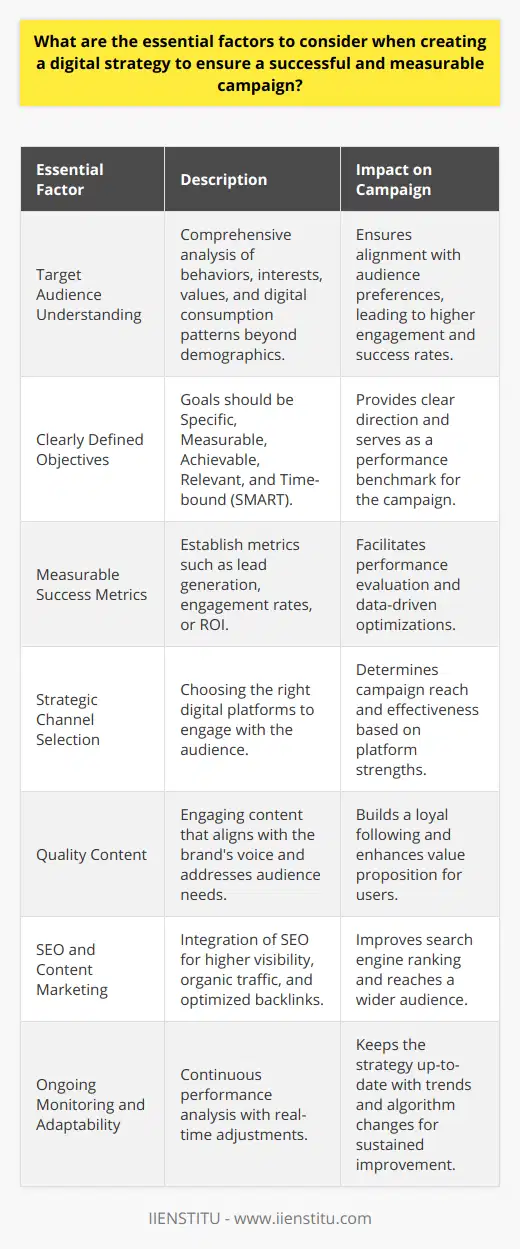
How does the integration of the 7 P's of digital marketing contribute to the overall effectiveness of a digital marketing strategy?
The Integration of 7 P's of Digital Marketing
Product Development and Enhancement
The integration of the 7 P's in a digital marketing strategy ensures that the product or service offered meets the needs and expectations of the target audience. By incorporating elements such as product features, design, and quality, businesses can offer solutions that satisfy consumer needs, ultimately contributing to the effectiveness of the marketing campaign.
Effective Price Management
Understanding the appropriate pricing of products or services in the digital marketing space is crucial for maintaining a competitive edge. The integration of the 7 P's allows marketers to analyze factors such as demand, cost, consumer willingness to pay, and competitor pricing, which in turn helps them develop optimal pricing strategies that maximize revenues and attract customers.
Channel Optimization with Place
The selection and management of channels are crucial in reaching the target audience and delivering the value proposition. The 7 P's integration aids marketers in identifying the most relevant platforms, websites, or social media networks to connect with potential customers. This strategic approach ensures that businesses invest their efforts and resources in the right places, resulting in higher ROI and better reach.
Promotion Strategies and Tactics
Digital marketing success largely depends on the effectiveness of promotional measures adopted. The 7 P's integration enables businesses to establish well-rounded strategies that include various promotional elements such as advertising, public relations, and sales promotions. By employing these tactics, marketers can effectively communicate the value proposition, engage with the target audience, and achieve desired outcomes.
Personalized Consumer Experience
Assuring that the marketing efforts address consumer preferences and provide personalized experiences is crucial in digital marketing. The integration of the 7 P's allows businesses to create tailored marketing strategies, which can be fine-tuned according to individual consumer preferences, resulting in stronger customer relationships and improved marketing effectiveness.
Emphasizing Process Efficiency
The integration of the 7 P's ensures streamlined management of digital marketing routines, enhancing operations efficiency. This approach facilitates continuous process improvement and enables marketers to optimize their tactics, which in turn results in increased customer satisfaction, retention, and overall marketing performance.
Enhanced Physical Evidence
While digital marketing operates primarily online, the presentation and environment experienced by consumers are still important elements to consider. The 7 P's integration allows marketers to ensure brand consistency, user-friendly website design, and positive consumer experiences, which contribute to the overall effectiveness of their digital marketing strategy.
In conclusion, the integration of the 7 P's of digital marketing contributes to the overall effectiveness of a digital marketing strategy by ensuring that attention is given to all important aspects. This approach provides a comprehensive framework for businesses, which optimizes operations and improves marketing success.
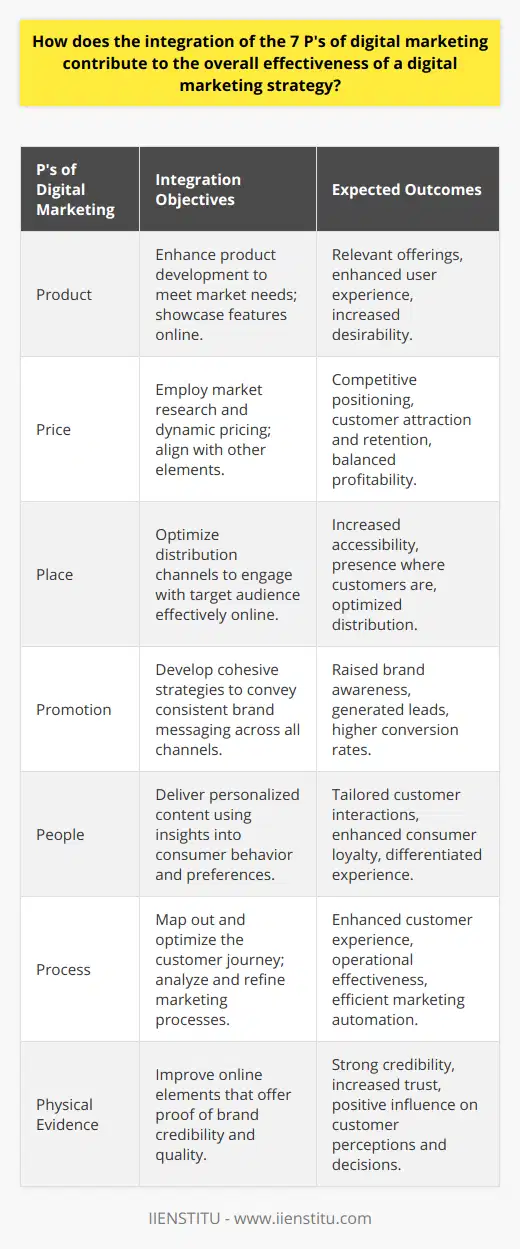
How do you create a digital strategy that effectively aligns with your business objectives and target audience needs?
Understanding Business Objectives
To create a digital strategy that effectively aligns with a business's objectives and target audience needs, one must first have a deep understanding of the business goals and objectives. This encompasses the mission, vision, and core values of the business, as well as the specific targets and milestones it aims to achieve. It is crucial to identify the primary drivers of the business, such as revenue growth, customer acquisition, or brand awareness, as well as the specific key performance indicators (KPIs) that will measure the success of the strategy.
Identifying Target Audience Needs
Additionally, understanding the target audience's needs and preferences is essential for developing a relevant and impactful digital strategy. This can be achieved by gathering and analyzing data through market research, customer surveys, and online analytics tools. It is important to segment the audience into distinct groups based on demographics, psychographics, and customer behavior patterns to tailor the digital strategy accordingly. Furthermore, keeping up-to-date with emerging trends and consumer preferences aids in crafting an adaptive and flexible digital strategy.
Aligning Strategy with Objectives and Needs
Once the business objectives and target audience needs have been identified and analyzed, it is time to develop a digital strategy that aligns with these factors. This requires selecting the most appropriate digital channels, such as social media platforms, email marketing, or search engine optimization, that will best reach and engage the target audience. The chosen channels should correspond to the target audience's online preferences and behavior, while also effectively delivering on the business objectives.
Creating a Cohesive Content Plan
A cohesive content plan is the backbone of any effective digital strategy. Content should be tailored to meet the needs and preferences of the target audience while also addressing the overall business objectives. This may entail creating informative blog posts, engaging social media content, or targeted email campaigns. It is essential to maintain consistency in brand messaging, tone, and visual aesthetic to create a cohesive and powerful content plan that resonates with the target audience.
Measuring and Adjusting the Strategy
Finally, it is crucial to continuously monitor and evaluate the performance of the digital strategy. This involves gathering and scrutinizing data related to the previously identified KPIs to determine the effectiveness of the initiatives in achieving the business objectives and meeting the target audience's needs. Based on this evaluation, adjustments and refinements can be made to the digital strategy to optimize its success and alignment with the business objectives and target audience needs.
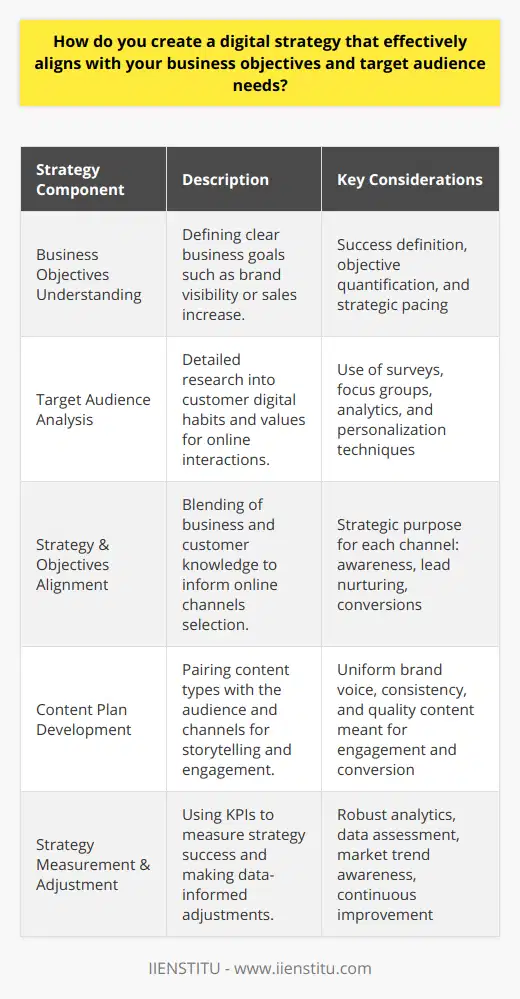
What are the primary considerations in implementing the 9 steps to creating a digital marketing strategy to maximize campaign efficacy and return on investment?
Understanding the Primary Considerations
When implementing the nine steps to creating a digital marketing strategy, it is critical to ensure campaign efficacy and maximize return on investment (ROI). The primary considerations are as follows:
Define Specific Objectives
An effective marketing strategy must have clear and concise objectives. It is essential to define specific goals to achieve within the campaign, such as increasing customer engagement or enhancing brand awareness.
Identify Target Audience
Determining the target audience helps tailor the campaign's content and approach to suit their preferences, improving the chances of achieving the desired goals. Segmenting the audience based on demographics and behavior patterns further enhances campaign effectiveness.
Competitor Analysis
Understanding competitors' strategies is crucial to establishing a competitive advantage, identifying gaps in the market, and ensuring that the devised digital marketing approach stands out among rival campaigns.
Develop a Content Strategy
A well-planned content strategy ensures that the marketing message is consistently delivered across various platforms. The content should be engaging, relevant, and informative to the target audience to maximize impact.
Select Appropriate Channels
Choosing the right digital channels for the marketing campaign is vital for reaching the desired audience effectively. Consider factors such as target audience, marketing goals, and channel-specific strengths when selecting appropriate channels.
Implement Tracking Tools
To measure campaign success, it is important to implement tracking tools such as analytics software, which will provide valuable insights into how the campaign is performing and identify areas for improvement.
Optimize Landing Pages
Landing page optimization is essential for improving conversion rates and driving higher ROI. This includes making sure website design is visually appealing, content is engaging, and the site is easy to navigate, leading to better user experiences.
Monitor and Analyze Results
Continuous monitoring and analysis of the campaign results help identify trends, monitor performance against goals and make data-driven decisions that improve the overall strategy. Adjustments can be made in response to the campaign's successes or failures.
Adjust Strategy as Needed
Digital marketing campaigns are not static; they require ongoing adjustments to maintain their effectiveness. Based on the data collected and analysis of performance, marketers must be willing to revise their strategy if necessary to maximize results and ROI.
In conclusion, it is essential to keep these primary considerations in mind when implementing the nine steps to creating a digital marketing strategy. Doing so maximizes campaign efficacy and return on investment, leading to better overall marketing outcomes.
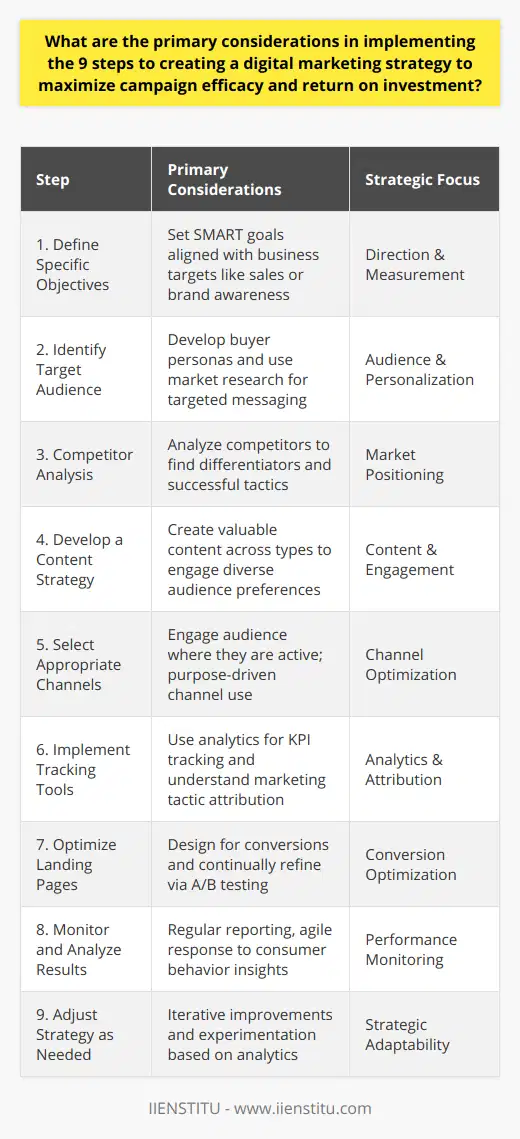
How can the 7 P's of digital marketing be tailored and adapted to suit various industries and sectors while maintaining a consistent, cohesive approach to online marketing?
Adapting the 7 P's for Industry-Specific Needs
The 7 P’s of digital marketing–Product, Price, Place, Promotion, People, Process, and Physical evidence–form a comprehensive framework for any organization's online marketing efforts. By tailoring these elements to cater to various industries and sectors, businesses can develop a distinct and cohesive online presence. The key to successfully adapting the 7 P’s lies in understanding the unique challenges and opportunities that different industries face while maintaining a consistent approach towards digital marketing.
Product Adaptation in Diverse Industries
For Product, businesses must first ensure their offerings specifically cater to the unique needs and preferences of their targeted customers. This can be achieved by conducting in-depth market research and understanding the market dynamics of the industry the business operates in. For instance, a fashion retail brand must consistently innovate and introduce new designs in response to evolving fashion trends, whereas a software company must continually update its products to meet changing technological demands.
Pricing Strategies for Competitive Success
Price adaptation involves setting prices that reflect the value perceived by customers in a specific industry. Factors such as market competition, costs of production, distribution channels, and customer expectations all contribute to planning an appropriate pricing strategy. For example, a luxury hotel may adopt a premium price, while a fast-food outlet targets cost-conscious consumers with affordable pricing.
Place: Maximizing Online Reach
In the context of digital marketing, Place refers to the online channels through which businesses promote their offerings. Companies must analyze their audience's preferences and habits in a particular industry to choose the most effective digital channels. For example, while social media might be ideal for a retail brand targeting younger consumers, an industrial equipment supplier may find better traction in targeting decision-makers via professional networking platforms like LinkedIn.
Promotion: Targeted, Engaging Content
An industry-specific Promotion approach involves creating targeted, engaging content that effectively communicates the brand's unique selling proposition. Companies must adapt their messaging, visuals, and tone of voice to attract and retain customers within their specific industry. For example, a health supplement brand must emphasize scientific research and testimonials, whereas a gaming company focuses on exciting graphics and immersive experiences.
People: Emphasizing Industry Expertise
The human aspect, or People, is critical for delivering exceptional customer experiences in a digital marketing context. This requires hiring and nurturing talent with industry-specific knowledge and expertise. For example, a digital marketing agency that specializes in financial services would need a team with a deep understanding of banking and finance trends to effectively engage with their target audience.
Process: Streamlining Industry-Specific Operations
Process adaptation involves streamlining internal operations to improve efficiency and meet industry-specific requirements. Companies must implement systems and technologies to automate repetitive tasks, optimize workflows, and ensure timely delivery of digital marketing activities. For example, an e-commerce company must adopt robust logistics infrastructure to enable swift deliveries, while a software firm must have a well-defined process for product updates and customer support.
Physical Evidence: Enhancing Digital Touchpoints
Lastly, Physical evidence entails ensuring consistency and professionalism across all digital touchpoints. Businesses must tailor their online brand presence, such as website design, logos, and social media graphics, to reflect industry-specific aesthetic preferences and expectations. For example, a pharmaceutical company's website should convey trust and expertise with a clean, professional design, while a fashion retailer aims for an aesthetic that mirrors the latest style trends.
In conclusion, adapting the 7 P's of digital marketing to suit various industries and sectors allows businesses to maintain a consistent, cohesive approach to online marketing. Understanding and addressing the unique requirements of specific industries enables organizations to more effectively engage with their target audience, develop brand loyalty, and ultimately achieve marketing objectives.
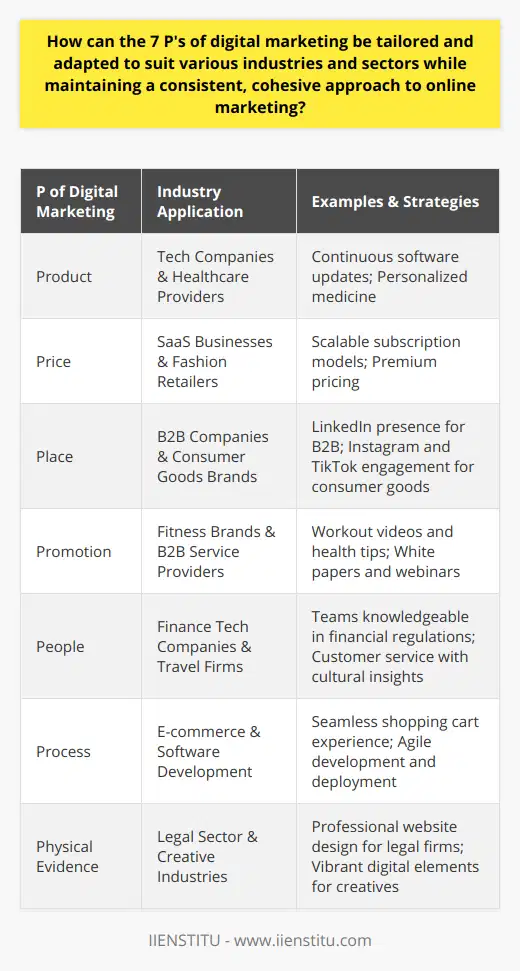
How do I formulate a digital marketing strategy that addresses the evolving market dynamics and emerging trends in consumer behavior?
Understanding the Target Audience and Trends
To formulate a digital marketing strategy that addresses the evolving market dynamics and emerging trends in consumer behavior, comprehending the target audience's characteristics is of paramount importance. This involves researching demographics, psychographics, and behavioral patterns of the target market to align marketing efforts effectively.
Leveraging Data and Technology
Harnessing data from digital touchpoints such as websites, social media, and email marketing can facilitate a better understanding of the target consumer's preferences and behaviors. Employing technologies like artificial intelligence and machine learning can provide predictive insights into future trends and market dynamics, enabling marketers to adapt their campaigns accordingly.
Utilizing Omnichannel Marketing Approach
Consumers increasingly interact with brands through multiple channels, making it crucial for marketers to implement an integrated approach to reach them effectively. An omnichannel marketing strategy involves executing coordinated marketing efforts across various digital channels such as social media, email, mobile apps, and websites. This approach enhances customer experience and drives brand consistency.
Personalizing Marketing Content
Personalization is a critical aspect of contemporary digital marketing, driving engagement and customer loyalty. By leveraging customer data, marketers can create tailored content that speaks directly to individual consumers, addressing their unique needs and preferences. This fosters improved brand perception and encourages continued engagement with the brand's products or services.
Embracing Agile Marketing
In the ever-evolving digital landscape, adopting an agile approach to marketing efforts enables businesses to nimbly respond to market shifts and consumer behavior changes. Agile marketing relies on iterative, flexible, and data-driven methods to optimize campaigns and quickly adapt to emerging trends, thereby ensuring marketing strategies remain effective in the face of change.
Measuring and Optimizing Campaign Performance
Monitoring, measuring, and optimizing the performance of digital marketing campaigns is crucial to consistently achieve desired outcomes. By employing key performance indicators (KPIs) and data analytics tools, marketers can gauge the success of their campaigns and make data-driven decisions to refine their strategies, ensuring marketing efforts remain aligned with evolving consumer behaviors and market dynamics.
In conclusion, formulating a digital marketing strategy that addresses the evolving market dynamics and emerging trends in consumer behavior requires understanding the target audience, leveraging technology, adopting an omnichannel approach, personalizing content, embracing agile marketing, and measuring campaign performance. Implementing these practices will ensure a strategic, well-rounded, and adaptable approach to digital marketing success.
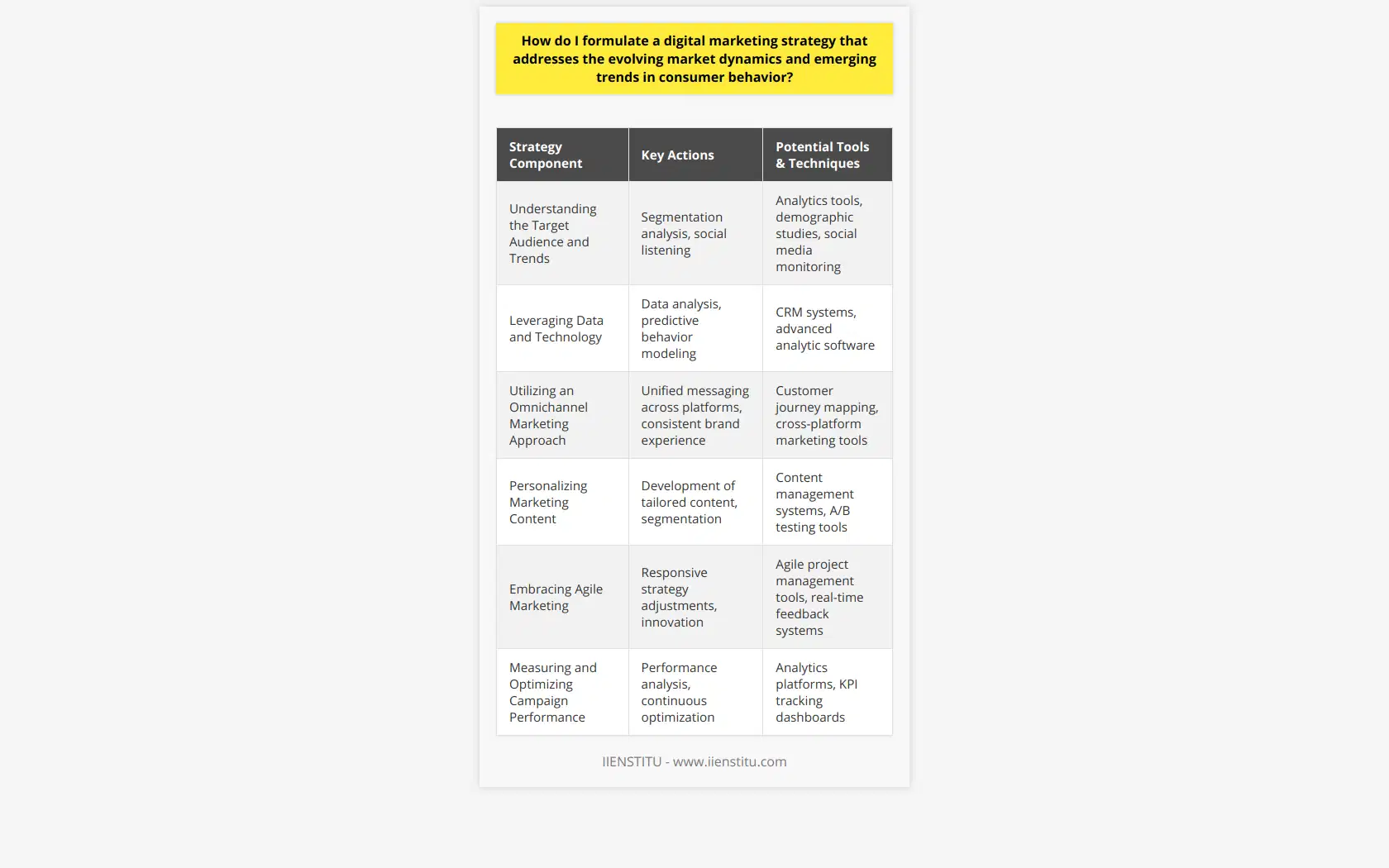
What are the key steps and best practices for creating a digital strategy that optimizes resources and maximizes return on investment?
Understanding the Objectives
A successful digital strategy starts with a clear understanding of the organization's objectives, desired outcomes, and target audience. Aligning these elements lays the foundation for a focused and effective strategy.
Comprehensive Market Assessment
Perform a comprehensive market assessment to identify market trends, competitors, and potential customer segments. Analyzing these elements will help organizations make informed decisions and tailor their digital strategies accordingly.
Developing Customer Personas
Develop customer personas representing the target audience to enhance the strategy's effectiveness. These personas should be based on data-driven insights and considered throughout the entire strategy development process, ensuring a customer-centric approach.
Establishing Key Performance Indicators (KPIs)
Determine relevant KPIs to measure the success of the digital strategy. Incorporate a mix of both qualitative and quantitative metrics to track performance and adjust the strategy as needed, maximizing return on investment.
Choosing Appropriate Channels
Identify the most effective digital channels that resonate with the target audience. Organizations should be selective about which channels to use, ensuring they align with the objectives, audience, and available resources.
Creating Engaging Content
Develop high-quality, engaging content based on the identified customer personas and objectives. Content should speak to the audience's needs and interests, working towards creating lasting relationships and driving conversion.
Setting a Realistic Budget
Determine a realistic budget for the digital strategy, accounting for resources such as time, personnel, and marketing tools. A well-allocated budget ensures that resources are optimized and potential return on investment is maximized.
Implementation and Monitoring
Execute the digital strategy by working through the established channels, content, and tactics. Regular monitoring and tracking of KPIs ensure the ongoing effectiveness of the strategy, allowing for adjustments and optimization as needed.
Testing and Optimizing
Utilize data-driven techniques, such as A/B testing, to refine the digital strategy continuously. Testing and optimizing are essential, ensuring that resources are used efficiently while maximizing return on investment.
Regular Review and Adjustment
Conduct regular reviews of the digital strategy, analyzing performance data to determine successes and areas of improvement. Adjust the strategy as needed, responding to changing market conditions, and continually maximizing return on investment.
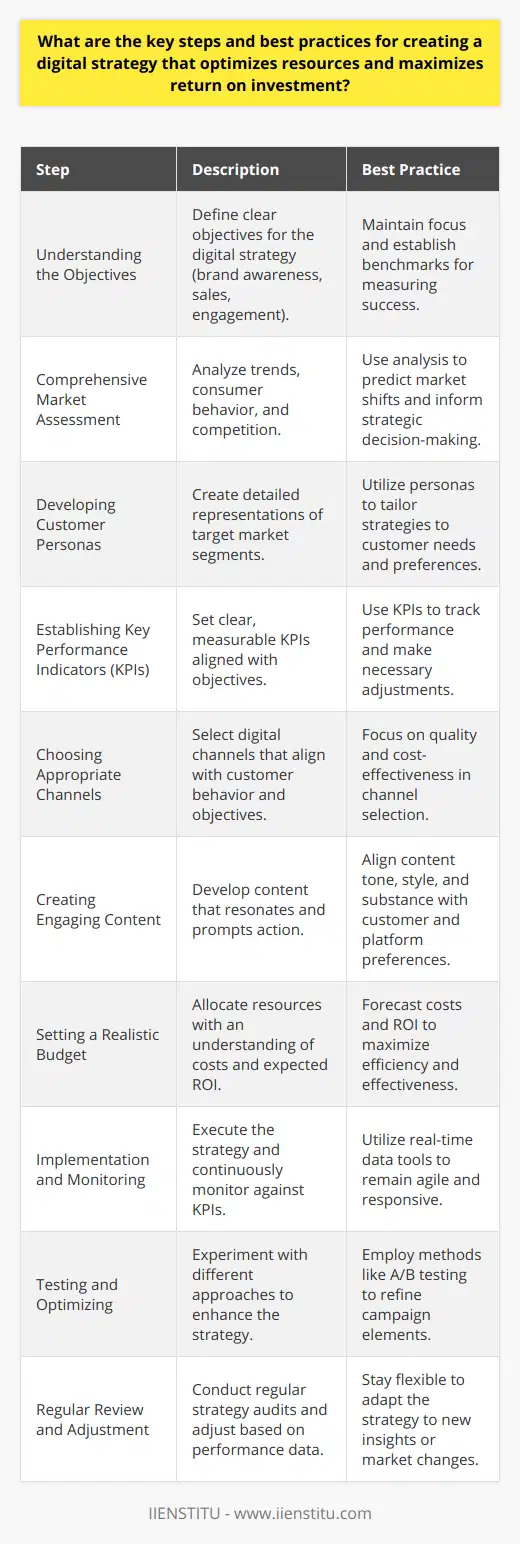
How can the integrative framework of the 9 steps to creating a digital marketing strategy be customized to meet the specific needs and goals of a wide range of businesses and industries?
Integrative Framework Adaptation
For businesses and industries to customize the integrative framework of the 9 steps to creating a digital marketing strategy, they must consider their specific needs, goals, and context. The following modifications will help in tailoring the framework to fit various scenarios.
Audience Targeting
The target audience must be identified based on each business's unique customer profile. This process will enable the design of a customized digital marketing strategy that aligns with their preferences, behavior, and demographics.
Goals and Objectives
The strategic objectives and goals of a business should drive the overall direction of the digital marketing strategy. The framework must be adapted to incorporate these objectives and support the specific industry context in which the business operates.
Budget Allocation
Each business must allocate their resources according to their strategic priorities and financial capabilities. A customized digital marketing strategy will need to take into account the available budget and allocate funds accordingly to achieve the desired outcomes.
Content Strategy
A tailored content strategy will ensure that the digital marketing plan resonates with the target audience in the context of the specific industry. Developing industry-specific content will enable businesses to engage with their customers and build trust more effectively than using generic content.
Channel Selection
Identifying the most relevant channels for your target audience is crucial for achieving marketing objectives. The integrative framework must be adapted to focus on the platforms that generate the highest engagement and conversion rates for businesses within a specific industry.
Performance Metrics
Customizing performance metrics is essential for measuring and optimizing the success of a digital marketing strategy in a specific context. Businesses must identify the key performance indicators (KPIs) that align with their goals and industry standards.
Integration with Offline Channels
Integration of digital and offline channels can maximize the impact of the marketing strategy for businesses operating in various industries. Adapting the framework to include offline touchpoints will ensure a seamless, consistent brand experience for customers.
Continuous Improvement
A customized digital marketing strategy should prioritize ongoing optimization, including regular analyses of data and refinement of initiatives based on insights gained. Businesses should establish a process for iterative improvement, ensuring that their digital marketing efforts evolve in alignment with their unique needs.
Flexible Implementation
Finally, the customizability of the integrative framework necessitates a flexible approach to implementation. Adaptation to changing market conditions, shifting consumer preferences, and emergent technologies will enable businesses across industries to remain competitive and agile in their digital marketing efforts.
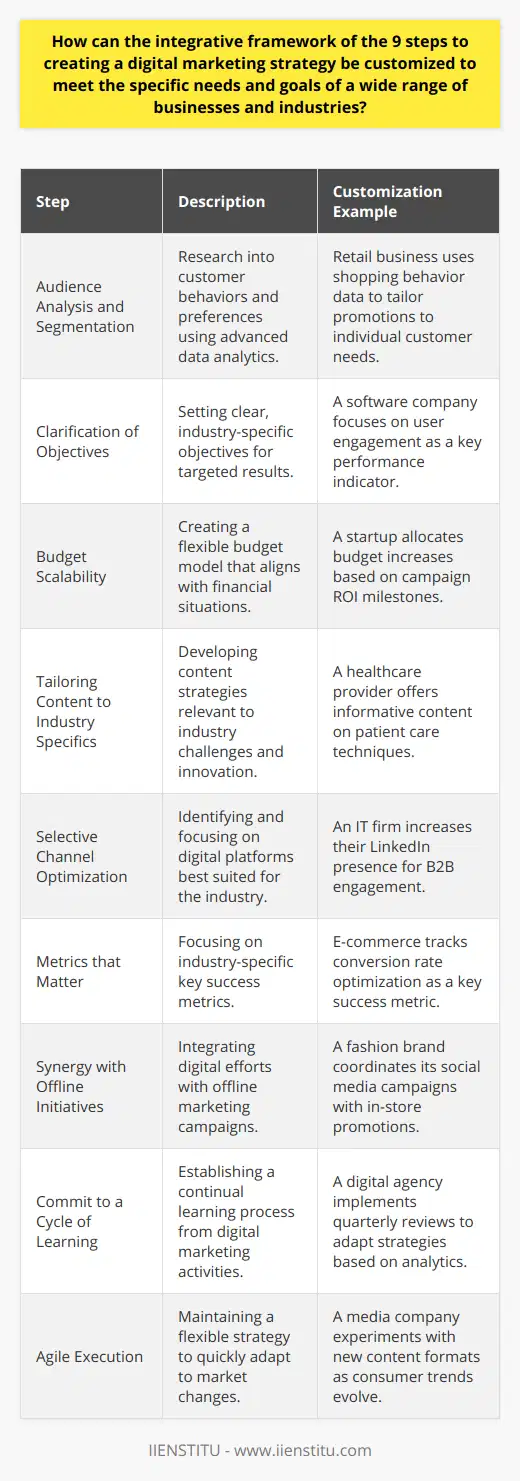
What are the critical components and best practices involved in each of the 5 stages of planning a digital marketing strategy, and how can they be successfully applied?
Understanding the Critical Components of Digital Marketing Strategy Stages
Stage 1: Analysis and Research
In the first stage, the critical components involve analyzing the existing market and identifying specific gaps, trends, and customer needs. Best practices include conducting comprehensive research on industry data, competitor strategies, and audience behavior. To apply these effectively, marketers should consistently gather, monitor, and update relevant data, focusing on areas that align with their brand goals and customer requirements.
Stage 2: Goal Setting and KPIs
The second stage entails setting clear, measurable objectives and key performance indicators (KPIs) for the digital marketing strategy. Best practices include setting SMART (specific, measurable, achievable, relevant, time-bound) goals and regularly assessing KPIs against these objectives. To successfully apply this stage, marketers should create a documented plan and constantly review progress, adjusting their approaches as needed.
Stage 3: Channel Selection and Budget Allocation
The critical components in this stage are selecting the most appropriate marketing channels and allocating resources effectively. Best practices incorporate evaluating the potential return on investment (ROI) for each channel, considering both short-term outcomes and long-term growth. Applied successfully, marketers will allocate funds based on data-driven analyses and prioritize marketing channels with proven benefits and compatibility with their target audience.
Stage 4: Content and Campaign Development
This stage involves creating engaging content and designing digital marketing campaigns that resonate with the target audience. Critical components include formulating an authentic brand story, generating quality content, and utilizing data-driven insights to tailor campaigns. Best practices feature designing content that aligns with customer personas, reflects brand values, and addresses pain points effectively. Marketers can successfully apply these by continuously refining their content strategy based on performance and audience feedback.
Stage 5: Implementation, Monitoring, and Optimization
During the final stage, the critical components involve implementing the strategy, monitoring its performance, and optimizing efforts as needed. Best practices include maintaining a structured timeline of marketing activities and leveraging analytics tools to measure performance. To apply these successfully, marketers should actively track KPIs, assess the effectiveness of each marketing channel, and implement adjustments accordingly to enhance the strategy's overall impact.
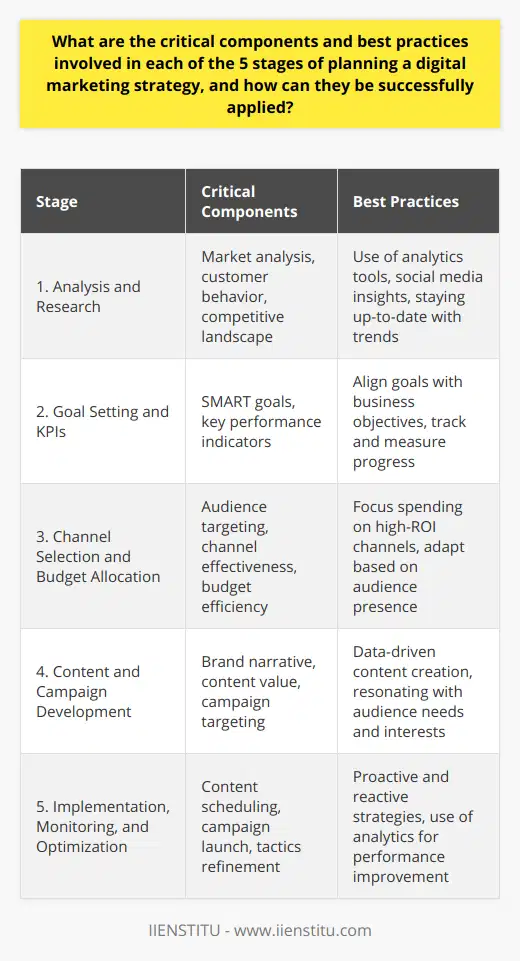
How do the 7 P's of digital marketing differ from traditional marketing principles, and what unique advantages do they offer in today's digital landscape?
The Evolving Marketing Principles
The 7 P's of digital marketing, comprising product, price, place, promotion, people, process, and physical evidence, differentiate themselves from traditional marketing principles by capitalizing on the unique advantages offered by today's digital landscape. This enables businesses to reach and engage with their target audience more effectively.
Adapting to Digital Products
In the realm of digital marketing, the concept of 'product' has evolved to encompass not only tangible goods and services but also digital and virtual offerings, such as mobile applications, online courses, and streaming platforms. This development provides businesses with the opportunity to cater to the needs and preferences of an increasingly digital-savvy consumer base.
Dynamic Pricing Strategies
Digital marketing allows businesses to implement dynamic pricing strategies, facilitated by the vast amount of data and consumer behavior insights available online. It enables marketers to offer personalized pricing and promotions to different segments of their target audience, leading to increased sales and improved customer retention.
Location-Independence
The 'place' component of digital marketing signifies the distribution channels and platforms that businesses use to deliver their offerings to the market. The digital landscape allows for location-independent deliveries, thereby eliminating geographical constraints and facilitating global expansion opportunities.
Holistic Promotion Techniques
The promotion element of digital marketing focuses on utilizing various online channels, such as social media, search engine optimization, email marketing, and content marketing, through an integrated approach. This multi-faceted strategy enables businesses to reach and engage with their target audience effectively.
Importance of People
The people aspect of digital marketing highlights the significance of human resources, including talent acquisition, employee training, and personnel management, in achieving successful digital campaigns. As digital marketing demands a unique skillset, employers must ensure their workforce is well-equipped to execute their digital marketing strategies.
Streamlining Processes
Digital marketing allows businesses to optimize their internal and external processes by leveraging a wide array of tools and technologies. For instance, marketing automation, analytics, and customer relationship management systems streamline operations and produce more accurate insights into campaign performance.
Enabling Physical Evidence
Lastly, the physical evidence component underscores the importance of demonstrating tangible proof of a business's credibility and legitimacy in the largely intangible digital space. This can be achieved by showcasing customer testimonials, social proof, or physical representations of the services offered.
In conclusion, the 7 P's of digital marketing offer unique advantages over traditional marketing principles, such as enhanced adaptability, flexibility, and efficiency. This evolution allows businesses to capitalize on the opportunities presented by the digital landscape, providing them with a competitive edge in an increasingly interconnected and technology-driven world.
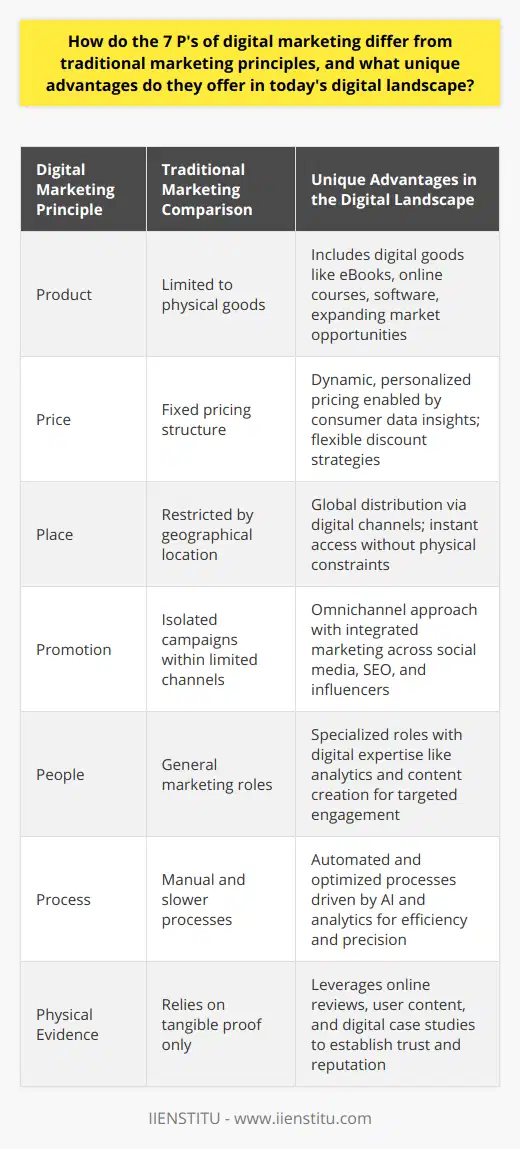
In what ways can the 10 steps to creating a digital marketing strategy be streamlined and adapted to accommodate varying organizational structures, resources, and objectives?
Adapting to Organizational Structure
One way to streamline the 10 steps is by customizing them to fit different organizational structures. Hierarchical models may need more top-down planning, while networked organizations may involve more cross-functional teams. By adjusting the approach according to the specific structure, the digital marketing process can become more efficient and relevant.
Resource Allocation and Prioritization
Another adaptation involves tailoring the plan based on available resources, especially for smaller businesses or startups. Instead of executing all steps, organizations can focus on priorities that are critical for immediate success. This approach makes it essential to identify the most valuable tactics and allocate resources accordingly.
Setting Realistic Objectives
The digital marketing strategy should always align with the organization's overall objectives. In order to accommodate varying goals, the 10 steps should be flexible enough to facilitate realistic objectives. This involves creating SMART (Specific, Measurable, Achievable, Relevant, Time-bound) goals that can be adjusted and monitored throughout the implementation process.
Embracing Agility and Adaptability
In an ever-changing digital landscape, the ability to adapt and respond quickly is vital. Organizations should regularly evaluate the effectiveness of their marketing strategies and adjust as needed. This may involve refining goals or reallocating resources based on data-driven insights to optimize the overall marketing approach.
Integrating Different Marketing Channels
Lastly, the digital marketing strategy should be adaptable to different marketing channels, allowing for seamless integration. Organizations should carefully select the best channels to reach their target audience and ensure that the message remains consistent throughout. By integrating different channels effectively, organizations can amplify their marketing efforts.
In conclusion, streamlining and adapting the 10 steps to creating a digital marketing strategy involves customizing the plan to fit different organizational structures, resources, objectives, and channels. By ensuring agility and adaptability, businesses can optimize their digital marketing efforts and better achieve their goals.
